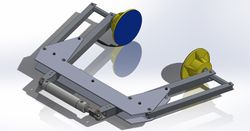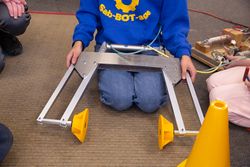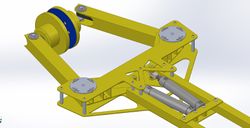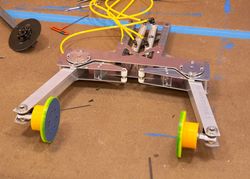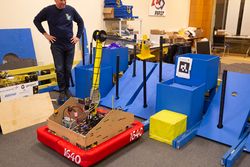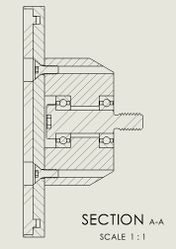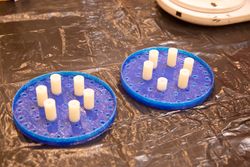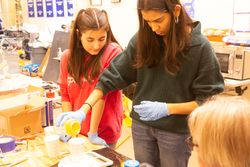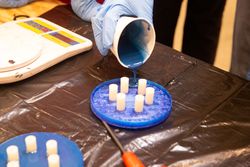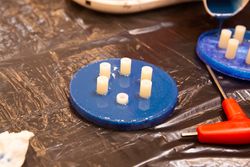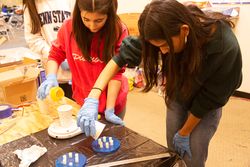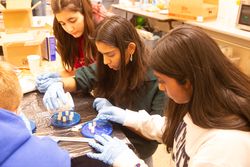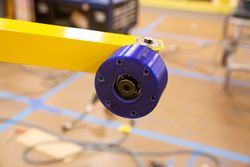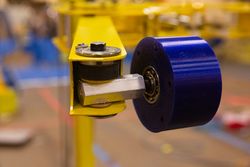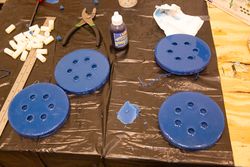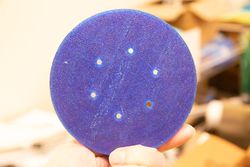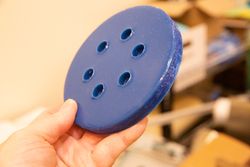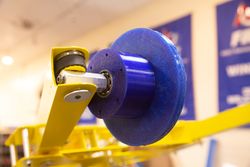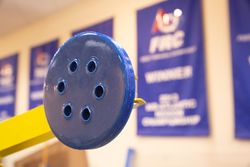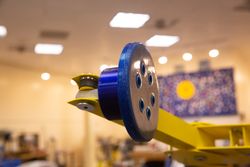DEWBOT XVIII Monkey Claw
The challenge is in managing two very different game pieces (CONEs and CUBEs) with a specific orientation needed for scoring CONEs at the top and middle rows (by needing to score CONEs on these rows on pipes).
Plus, how to pick up both types of game pieces from the floor? With CONEs either upright or on their side.
Contents
Scoring - GRIDs, NODEs, CONEs & CUBEs
Each alliance has 27 Scoring NODEs arranged in three (3) ROWs (Top, Middle & Bottom) and three (3) GRIDs (Outer - CO-OP - Outer). Each Scoring NODE can accommodate one (1) Game Piece. Scoring is capped by the number of Scoring NODEs.
Scoring NODEs in the Top and Middle ROWs are Game Piece specific. There are twelve (12) CONE NODEs and (6) CUBE NODEs per alliance, equally split between the Top and Middle ROWs. CONE NODEs are upright 1-1/4" Sch 40 Pipe. Tops of the Middle ROW CONE NODEs are 2' 10" above the field carpet and 1' 10-3/4" from the GRID front; tops of the Top ROW CONE NODES are 3' 10" above the field carpet and 3' 3-3/4" from the GRID front. CUBE Nodes are 1' 6-1/4" wide x 1' 5" deep polycarbonate shelves with 3" tall walls. Top of the Middle ROW CUBE NODEs are 1' 11-1/2" and TOP ROW NODEs are 2' 11-1/2" above the field carpet. Top and Middle ROW NODEs are arranged in each GRID as CONE - CUBE - CONE.
Scoring NODEs in the Bottom ROW are HYBRID NODEs and may be scored by either Game Piece (CONE or CUBE). HYBRID NODES are constrained areas of field carpet.
Scoring per Game Piece is determined by ROW: 2 points for the Bottom ROW; 3 for the Middle ROW; 5 for the Top ROW in teleop. Game Pieces scores in autonomous earn one additional point each regardless of ROW.
Three (3) Game Pieces scored contiguously in a ROW are a LINK and earn 5 additional points. In the Top and Middle ROWS LINKs are necessarily (2) CONES and (1) CUBE. An alliance scoring 5 or more LINKs in a qualifying match earn an additional RANKING POINT.
CUBEs are light (~71g), inflated "balls with corners" of about 9-1/2" diameter. They are fragile. Orientation in unimportant during scoring. Pretty easy.
CONEs are heavier (~653g), 12-13/16" tall rubber safety cone. Not fragile (in the Bachman-Turner Overdrive sense). It's a cone, so the diameter tapers towards the top. Orientation during scoring is important (for Top & Middle ROWs), as the top of the CONE NODE must be fully contained withing the CONE. The bottom of the CONE needs to be down when scoring on the CONE NODE.
A ROBOT may only possess one (1) Game Piece at a time.
Each ROBOT may pre-load (1) Game Piece. Each alliance may pre-position (4) Game Pieces at specific points on the field.
All other Game Pieces must be obtained from SUBSTATIONS in the alliance's LOADING ZONE. A total of 54 CONES and 44 CUBES are divided equally between the two alliances (27 CONES and 22 CUBES per alliance).
First Thoughts - Roller Claws and in-Chassis Intakes
A number of Roller Claws and chassis-based Game Piece alignment mechanisms were designs and/or tested, but without a great deal of success. Achieving rapid and reliable CONE alignment and Scoring Orientation were the overriding challenge.
Monkey Claw
An Ri3D Team Redux video showed a gripper using a pair of rotating paddles on a linear slide. The rotation of the paddles allows the CONE to reorient base-down for scoring based on mass (the base is heavy).
Based on this concept, a 4-bar gripper prototype was designed, built and tested. This worked well, but the 4-bar design makes the wastes a lot of width.
This gripper concept was christened the "Monkey Claw" because: 1) a GIF of a toy monkey banging cymbals was posted in the team's Slack; and 2) calling this the "spinney-grippy-thing" became awkward.
To use space (width) more efficiently, the Monkey Claw was redesigned to use synchronous pulleys and a belt to maintain the "cymbals" in the correct orientation.
The disks on top allow straightforward adjustment of the cymbal orientation.
The Monkey Claw is mounted on an Arm.
Monkey Cymbals
Basically 3-d printed wheel hubs bolted to a 5" diameter printed polyurethane disk surfaced with soft cast polyurethane. The cast polyurethane provides a grippy, high friction surface to the Cymbal. A shoulder bolt provides the wheel shaft. Bearings allow the cymbals to rotate freely.
